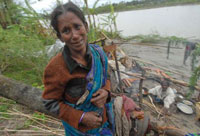Bangladesh Foreign Ministry asks for foreign aid for cyclone victims
Thousands of victims of Cyclone Sidr in Bangladesh need more foreign aid after the storm swept away the country's coast and killed over 3,150 people.

Food, fresh water and temporary shelter had still not reached many of the hungry and exhausted survivors.
"At this time we will welcome support from the international community," said a statement from Bangladesh Foreign Ministry. "We are doing as best as we can do ourselves."
In a televised speech on Tuesday, the country's interim leader, Fakhruddin Ahmed, described the cyclone as "a national calamity" and urged citizens to help the affected people.
Ahmed said he has decided against attending a Commonwealth summit in Kampala, the Ugandan capital, beginning Friday, because of the disaster.
The government said international aid worth about US$120 million (Ђ81.89 million) has so far been promised. But relief items such as tents, rice and water have been slow to reach most survivors of the worst cyclone to hit Bangladesh in a decade.
The European Commission announced on Tuesday an aid of US$9.6 million (Ђ6.5 million). The American Red Cross said it would provide US$1.2 million (Ђ819,000) to help get clean water to the survivors and build emergency shelters.
"The problem is that aid workers need hours to reach these remote areas. Poor communications are also hampering our work," said Anwarul Huq, a spokesman for the Bangladesh Rural Advancement Committee, the country's largest nonprofit development organization.
In many places, aid workers had to clear fallen trees and debris to get to survivors, said Huq, adding that rescuers also were facing a shortage of boats.
Nearly 3,000 volunteers from the committee have been distributing rice, lentils, salt, biscuits and candles to the survivors, he said.
At Patharghata, a hard-hit trading town on the Bay of Bengal, more than 100 women gathered Tuesday hoping to get aid.
"I've been waiting here for several hours hoping to get some food and drinking water," said Safura Begum, who has three children. "But I'm not sure it will come.
"Some biscuits and a few bottles of water are what I've gotten in the past three days," the 45-year-old said.
In the same area, a local aid agency has put dozens of children in a shelter and given them food and entertainment.
"Many of these children have been traumatized after watching the cyclone horror. We have bought them here to help them overcome the shock," said A. K. Azad, an official at Sankalpa, a child welfare agency.
The government is using helicopters to get aid to the survivors many of whom lost their homes in the cyclone and have been living out in the open.
Some relief agencies used boats to ferry relief aid to remote pockets. Catholic Relief Services used ferries and traditional fishing boats to send food and emergency relief material to nearly 1,000 families in Barisal district, one of the hardest hit by the cyclone.
The storm, which tore along Bangladesh's southwestern coast on Thursday, left tens of thousands of people homeless and desperate for help.
On Thursday night, Nasima Begum, 30, woke up to howling winds and high waves rolling from the sea into her thatched hut near Patharghata. Before her house collapsed she managed to gather her children and fight her way through the water to a nearby tree. She held on to the tree and asked the children to cling to her body.
"We were there for almost an hour before the storm subsided and the water began to recede. I don't know how I survived. But Allah has helped us," she said.
Five days after the cyclone the deadliest in a decade rescuers were still recovering human bodies and animal carcasses from the debris and pools of stagnant water.
On Tuesday, a small group of grieving relatives waited at Padma village near Pathargata to bury the decomposing body of a 7-year-old girl they found lying in a muddy rice paddy. The body was wrapped in paper for lack of a proper funeral shroud.
In Padma, a coastal village of about 3,000 people, almost every family lost someone to the cyclone.
By Tuesday the official death toll stood at 3,153 after reports reached Dhaka from storm-ravaged areas that had earlier been largely cut off because of washed-out roads and disrupted phone services, said Lt. Col. Main Ullah Chowdhury, a spokesman for the army that is coordinating the relief and rescue work.
Local media reports say more than 4,000 people may have been killed. The Bangladesh Red Crescent Society, the Islamic equivalent of the Red Cross, has suggested the final figure could be around 10,000.
Every year, storms batter Bangladesh, a delta nation of 150 million people, often killing a large number of people.
A similar cyclone in 1991 killed 139,000 people along the coast. The most recent deadly storm was a tornado that leveled 80 villages in northern Bangladesh in 1996, killing 621 people.
Subscribe to Pravda.Ru Telegram channel, Facebook, RSS!


